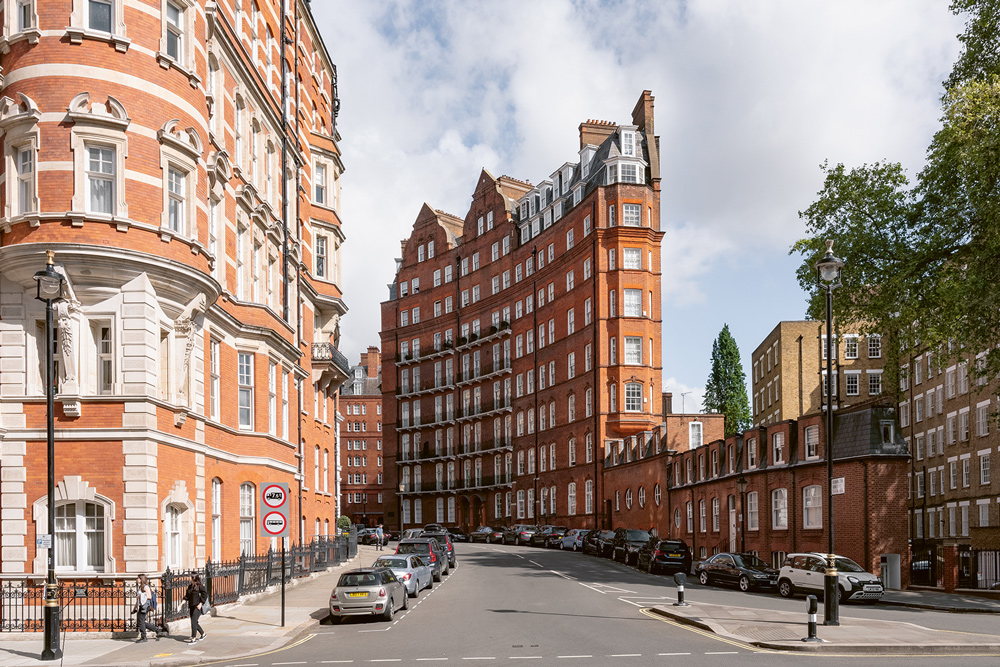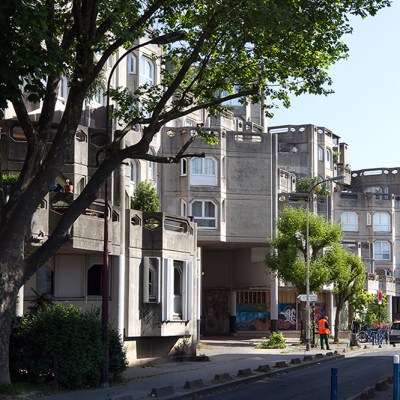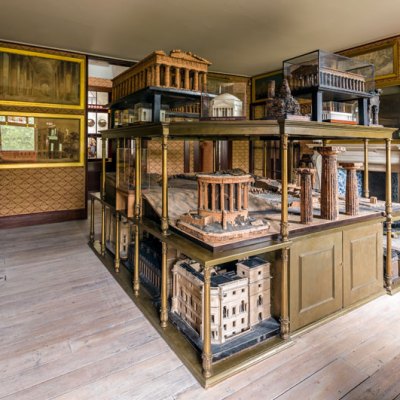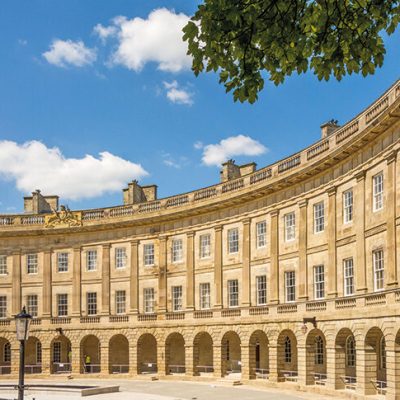From the July/August 2023 issue of Apollo. Preview and subscribe here.
In the 1760s the Adam brothers built a speculative housing development on an insalubrious patch of London between the Strand and the Thames. To appeal to punters, they used grand symmetry and pilasters to give the new terraces of the Adelphi the outward appearance of a single classical riverine palace. Financially, the scheme was a near-disaster, but the aesthetic ruse was a success. In the second half of the 19th century, with London’s booming middle classes needing places to live, and often reluctant to slog out to the new suburbs, builders again turned to the palace frontage. In 1852, as part of the creation of Victoria Street in Westminster, Henry Ashton designed a long Italianate six-storey block containing 36 large flats. With this, he created the London ‘mansion block’, a distinctive typology explored by Karin Templin in At Home in London: The Mansion Block, published in May by MACK and the Architecture Foundation. The mansion block prospered over the next half-century, and subsequently experienced two revivals: between the world wars, and from 2010 to the present day.
It’s this latest revival that makes Templin’s survey more than a vintage snapshot. One of the three-pipe problems of British politics: everyone wants more housing built, but people are often very resistant to anything being built near them. Conservative policymakers have in recent years treated the problem as largely aesthetic, sweetening the pill of new housing by promising ‘building beautiful’, ‘placemaking’ and so on. Sometimes this verges on simple euphemism: a ‘garden suburb’ might stir up fewer angry residents’ associations than a ‘housing estate’. Similarly, ‘mansion block’ sounds a more urbane neighbour than ‘block of flats’.
Which raises the question of whether it is truly a typology, or just a marketing gimmick to make apartment buildings more palatable to a suspicious public. Templin lays to rest some misconceptions about this. The Victorian Londoner was not as sceptical of apartment blocks as is generally assumed: the mansion block was widely advocated and welcomed. By 1911, more than 10 per cent of London’s population lived in flats. (These were generally rented, even for the upper-middle and upper classes: home ownership became a national obsession only later in the 20th century.)
Speculative building led to some extraordinary heaps, such as Queen Anne’s Mansions beside St James’s Park, designed by Henry Alers Hankey and E.R. Robson and built between 1873 and 1889. This piled 300 flats on 13 teetering floors, connected by the capital’s first residential hydraulic passenger lift. The facade, a monotonous grid of barely adorned windows, was slightly inflected, adding to the sense that it loomed over the street below. It was demolished in 1973. But generally the Victorian mansion block was distinguished by architectural unity, visible in the handsome red brick and pale stone blocks built around the Albert Hall by R. Norman Shaw and others. It is these blocks that are such a characteristic part of Chelsea, Marylebone and Mayfair. The density of population they permit, and the shops and restaurants they often incorporate, have done much to make those neighbourhoods attractive, as Templin explores.
Dolphin Square in Pimlico, London, designed by Gordon Jeeves (1888–1964) and built in 1937. Photo: Matthew Blunderfield; courtesy the artist and MACK; published in At Home in London: The Mansion Block by Karin Templin (MACK)

The second age of the mansion block, after the end of the First World War, came in a very different style, as art deco and neoclassicism elbowed aside Edwardian fanciness, and often on a very different scale. Previous efforts were dwarfed by red brick megastructures such as Du Cane Court in Balham – 632 flats – and Dolphin Square in Pimlico, with 1,310 flats, for a time the largest residential building in Europe.
These giant buildings were often meaner on the inside. Driven by modern ideas that stressed economy of space, and traditional housebuilders’ ideas about generosity of profit, the individual flats were shrinking. The interwar apartment block was the subject of satire. How to Live in a Flat (1936) is a collection of wonderful illustrations by Heath Robinson (glued together with a chatty text by K.R.G. Browne) showing the space-saving devices necessitated by a modern flat: dining tables that double as beds, baths that protrude out of the side of the building, and washing lines attached to hot-air balloons. Significantly, it is the middle classes who are under scrutiny, and made to look ridiculous for tolerating these innovations.
A similar message comes from Osbert Lancaster’s Pillar to Post: The Pocket Lamp of Architecture (1938), which gave the world the typologies ‘Stockbroker’s Tudor’, ‘By-Pass Variegated’ and so on. ‘Park Land Residential’, a block for the wealthy, and ‘LCC Residential’, for the working classes, are two halves of the same joke: it’s the same building, but the version for the working classes is nicer as it’s not on a busy road, the rent is lower and it has trees outside rather than shops.
These lampoons contributed to a sense that flats were good enough for the lower classes, and only the lower classes. After the Second World War, with modernist planning ascendant, apartment blocks were mostly designed without the street frontage characteristic of the mansion block. Floor plans were also regularised, partly as a result of the structural logic of the high-rise. In Lifted: A Cultural History of the Elevator (2014), Andreas Bernard writes about the homogenising effect of elevators on building plans: since an elevator shaft appears in the same place on every floor, it governs the rest of the layout, and repetition naturally follows.
An excellent feature of Templin’s book is its inclusion of floor plans, which help prove that there’s more to the mansion block than decorative twiddles and a better class of tenant. These plans are often fascinating, revealing great internal variety. This is partly dictated by the demands of a street frontage, and the deep bays, recesses and courtyards needed to give every room a window (so much easier when your block is a tower isolated in the middle of the site). And it’s a quality that lives in modern mansion blocks by architects including Peter Barber – the ultimate being the honeycomb interior of 79 Fitzjohns Avenue by Sergison Bates, completed last year.
From the July/August 2023 issue of Apollo. Preview and subscribe here.



